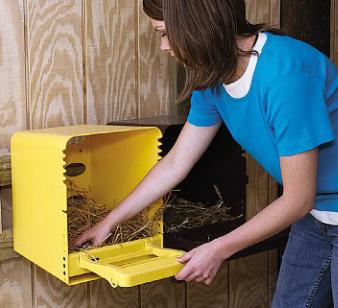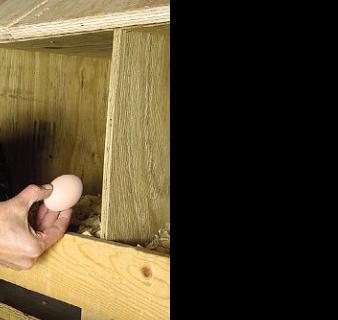SEO Version





www.premier1supplies.com • 1-800-282-6631
NESTING BOXES 21
Getting hens to lay
eggs in the nest…
Basics
Set up the nesting area so both you and
your birds have easy access to the nesting
boxes. If the box is too high the birds will
simply find another place to lay their eggs.
Too low and you’re breaking your back just
to gather the eggs.
Nesting boxes placed 2 ft above the
ground work well for all involved. It is
a height both of you can reach without
working too hard. Egg stealing pests
(snakes, skunks, etc.) have a hard time
reaching this height to snatch eggs as well.
Advantages of plastic
• Does not rust like metal or rot like wood
materials. Fade resistant.
• Much easier to clean and disinfect.
• No seams or cracks—reduces risk of
infestation by mites and possibly lice.
• No sharp edges or splinters.
Bedding
We prefer straw or hay bedding vs wood
chips. Both are abundant on our farms and
both stay in the nesting box better than
wood shavings.
Ceramic Nest Egg
Ceramic eggs spurs hens
to lay eggs in the nest.
They have the look, weight
and feel of real egg—so
much so that you should
mark them before use.
To use place the Ceramic Nest Egg in
the desired laying nest.
Ceramic Nest Egg, 0.1 lb ...........#530136 $1.24
(above) The best way to tempt your birds to try a
new nest box is to introduce fresh bedding in it.
(above) To discourage egg eating…place Ceramic
Nest Egg- in the desired nesting area. Hens won’t be
able to crack the egg and will quit.
The nesting area is the most critical and
interesting part of a chicken coop. That’s
where the end-product occurs—and it’s
where we humans must go daily.
Hens need a designated nesting area—in
which they feel comfortable and secure
enough to lay eggs.
Otherwise they will lay in locations you
typically wouldn’t like—and the eggs will
be dirty, cracked and harder to reach.
Our birds have, on occasion, hidden
their nests from us. Finding eggs a
month after they have been laid is not a
pleasurable experience…
So you need to provide a nest area
convenient to both you and the birds.
Nesting boxes should be:
• Easy to clean.
• Provide a sense of security to your
laying hens.
• Easy for you to collect the eggs.
If your hens haven’t immediately taken
to laying eggs in a nesting box, here are a
few hints:
• Many hens prefer a nest with other
eggs in it. So try placing a Ceramic
Nest Egg in the box
(see below)
.
• Place a comfortable amount of bedding
in the nesting box (we like straw or
similar bedding).
• Hens prefer to nest in areas where they
aren’t visible to potential predators. So
locate the nests in a dark and secure
part of the coop.
Powered by FlippingBook Publisher

